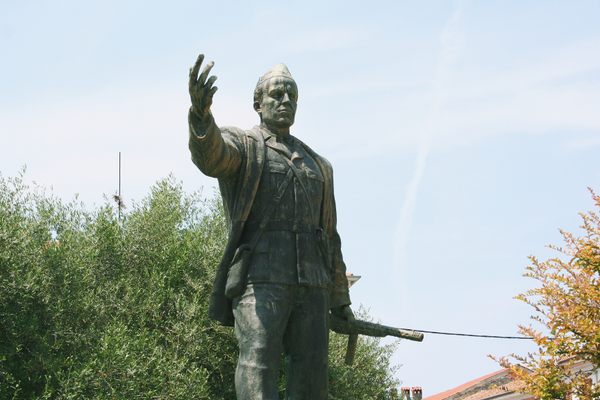About
Overlooking the town of New Ulm and the Minnesota River, the Hermann Heights Monument is topped by a statue of Arminius, a Cheruscan chieftain who, in the first century CE, formed a confederation of several Germanic tribes that, at the Battle of Teutoburg Forest, ambushed and destroyed three Roman legions. This victory under Arminius's command has been called "Rome's greatest defeat" and effectively brought an end to Roman designs on any territories east of the Rhine. This guy stopped the Empire in its tracks.
Hermann (as he is known is German) became a symbol for German independence, and then German unity, and then German exceptionalism. Hermann eventually became an important mythologized embodiment of militant German nationalism for both Imperial Germany and Nazi Germany. Thus, he's been tarnished for modern Germans, who don't really know or care much about Arminius.
How did he end up on top of a monument in Minnesota? Well, before the advent of Imperial Germany, some 7.5 million German immigrants came to the U.S. between 1820 and 1870. This more than doubled the population of the country, and the American public did not take kindly to this influx of non-English-speaking foreigners. Anti-German sentiment was common, sometimes escalating into full-blown riots.
In an effort to escape this harassment, a couple German organizations banded together to make a German settlement on the frontier, which at the time was Minnesota. The town was founded in 1854 and named New Ulm, after the city Ulm in Baden-Wuerttemberg. The Germans moved in while the indigenous Dakota were in the process of being pushed out, and New Ulm was a major flashpoint in the U.S.-Dakota War of 1862. After the war, the Dakota were expelled from Minnesota.
In 1875, the Sons of Hermann — a German-American fraternal/mutual protection society — decided to build a monument to Hermann in New Ulm, inspired by and modeled after the Hermannsdenkmal ("Hermann Monument") that had been completed in Detmold, Germany that same year. The American monument was completed in 1897 and added to the National Register of Historic Places in 1973. In 2000, the U.S. Congress designated the Hermann Heights Monument as "a national symbol for the contributions of Americans of German heritage."
Overall, the monument stands 102 feet high and includes a spiral staircase that affords access to a viewing platform inside the dome. The statue itself — known locally as "Hermann the German" — stands 32 feet high and is the third largest copper statue is the United States, after the Statue of Liberty and the Portlandia statue (non-hipster lady with trident) in Portland, Oregon.
Related Tags
Know Before You Go
From Broadway St in New Ulm, head southwest on Center St up the hill. The park is on the right. During the summer months, and for a $3 admission fee, one may climb the flights of stairs (and a ladder) to reach the feet of Hermann.
Community Contributors
Added By
Published
January 26, 2016































